Indulge in the creamy and tangy flavors of vegan Sindhi Kadhi, a cherished Indian dish featuring a delightful blend of besan (gram flour), ripe tomatoes, tangy tamarind, and hearty potatoes. This comforting Sindhi Curry is perfect for those seeking a delicious plant-based meal. Discover how to make this flavorful dish and savor its rich, aromatic goodness! Make it in 30 minutes!
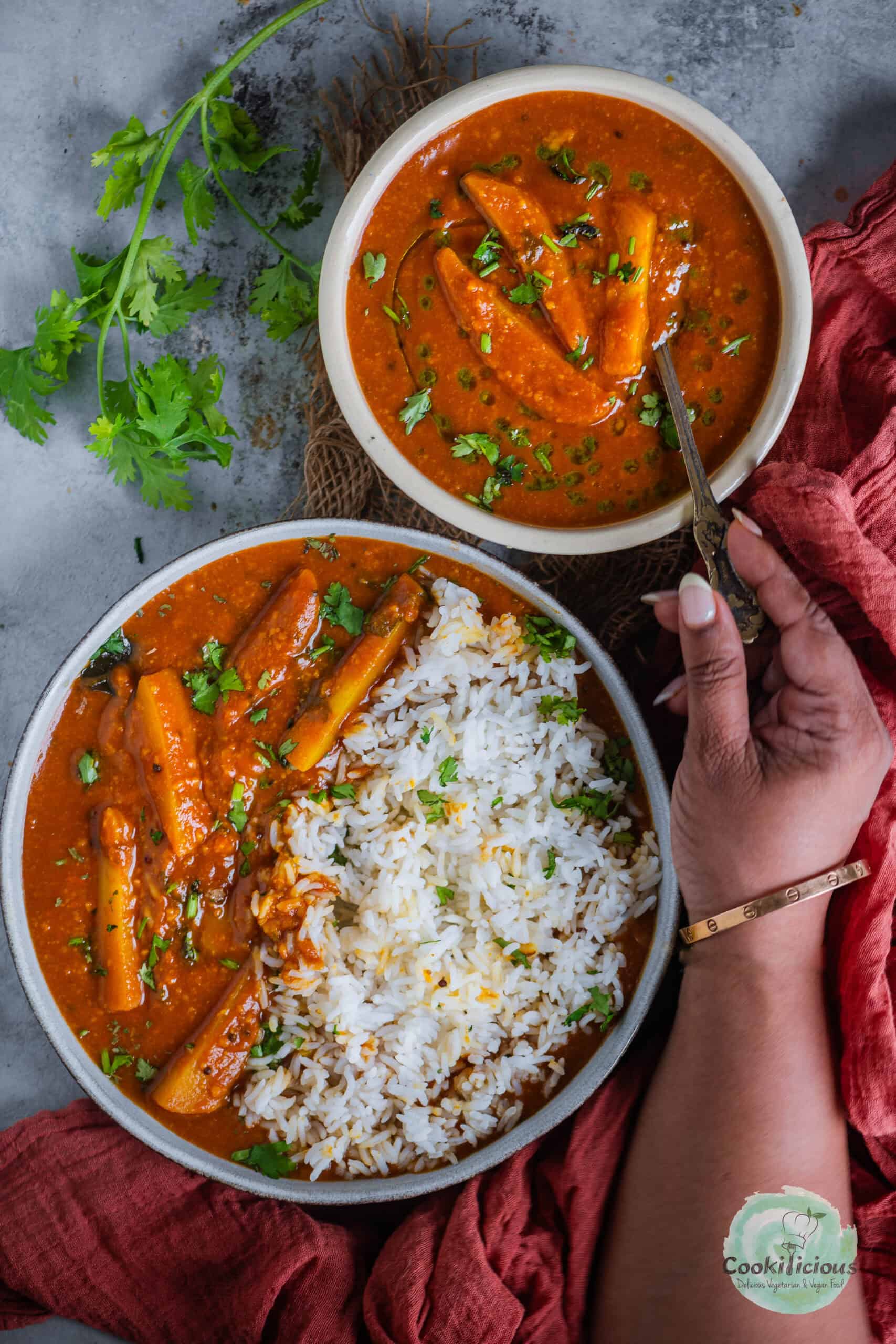
Jump to:
What is Kadhi
Kadhi is a classic Indian dish typically made with yogurt and chickpea flour (besan), spiced with a variety of seasonings. Known for its creamy and tangy flavor, Kadhi has a Dal Soup-like consistency and is often paired with rice (chawal) or roti. While it is a staple in many Indian households, each region of India has its version of Kadhi, featuring distinct ingredients and preparation styles. Kadhi is versatile, nourishing, and reflects the diversity of Indian culinary traditions, with each state offering its special take on this comforting dish.
Different Types of Kadhi Recipes
Here's a breakdown of some popular types of Indian Kadhi recipes:
Punjabi Kadhi: This rich and creamy Kadhi is made with yogurt and chickpea flour (besan) and features crispy fried pakoras (fritters), adding texture and substance. It is spiced with garlic, ginger, and green chilies, giving it a bold, tangy flavor.
Rajasthani Kadhi: Simpler yet spicier, this version is prepared with yogurt and besan but without pakoras. It has a thinner consistency and relies on mustard seeds, cumin seeds, and dried red chillies for a more intense flavor, often served with roti or rice.
Gujarati Kadhi: Light and mildly sweet, this variation is thinner and less spicy, balancing the tang of yogurt with jaggery or sugar. It is typically served with khichdi or steamed rice, offering a gentle, comforting taste.
South Indian Mor Kuzhambu: This Kadhi-like dish from Tamil Nadu is made with yogurt and coconut, tempered with curry leaves, mustard seeds, and green chilies. It's lighter and has a distinctive coconut flavor, often served with rice and vegetables.
Sindhi Kadhi: Unlike other Kadhis, Sindhi Kadhi is naturally vegan and is made without yogurt. Instead, it uses tamarind and tomatoes for tanginess and includes a variety of vegetables such as okra, potatoes, and drumsticks, making it hearty and flavorful. It's the best Kadhi recipe of them all!
What is Sindhi Curry
An authentic Sindhi Kadhi, also known as Sindhi Curry or Curry Chawara, is a tangy, mildly spiced curry made with gram flour (besan) and vegetables. Unlike most other kadhis, it doesn't use yogurt. Instead, the sourness comes from tamarind and tomatoes, making it a naturally vegan dish. This traditional comfort food from the Sindhi cuisine is a staple in many homes and is typically served with steamed rice.
A key feature of this dish is the balance of flavors-it's sweet, sour, salty, bitter, pungent, and astringent all at once. While some versions of Sindhi Besan Curry include a wide variety of vegetables like okra, potatoes, and drumsticks, every household has its take on the Sindhi Kadhi recipe. I like to make it with potatoes to keep it simple yet flavorful. This Sindhi veg recipe is also featured in my cookbook.
Traditionally, vegan Sindhi Curry is cooked in a special vessel called Sipri, enhancing its taste and authenticity. Another variation uses tur dal (split pigeon peas) instead of tomatoes. Sindhi Kadhi is a vibrant reflection of Sindhi cuisine, which originates from the Sindh province (now in Pakistan) and is known for its flavorful and easy-to-make recipes. If you're a fan of bold, balanced flavors, this restaurant-style Sindhi Besan Curry recipe is a must-try!
Love Sindhi food? Check out this Dal Pakwaan Tostadas recipe. It's yum! Some Pakistani-inspired recipes on the blog are Seviyan Kheer, Kofta Curry, Aloo Bharta, and Jhajhariya.
Sindhi Kadhi vs Sambhar
Although both dishes use tamarind for sourness and include vegetables, the recipe of Sindhi Kadhi offers a more subtle flavor profile compared to the bold, spice-rich Sambhar recipe. It also draws comparisons to Rasam due to similar ingredients but has a heartier texture and a distinct Sindhi touch. Both dishes are comforting, and wholesome, reflecting the culinary diversity of their respective regions.
Why Make It
- Vegan, Gluten-Free, Soy-Free, and Nut-Free: This dish is perfect for various dietary preferences and restrictions.
- One-Pot Comfort Food: A nourishing meal that's easy to prepare and clean up after.
- No Yogurt or Pakoras: Traditional flavors without dairy or fried elements.
- Quick Preparation: Ready in just 30 minutes, making it ideal for busy weeknights.
- Simple, Quick, and Easy to Make: Perfect for cooks of all skill levels, requiring minimal prep work.
- No Onion, No Garlic: A great option for those avoiding these ingredients, yet still full of flavor.
Ingredients Needed 🧾
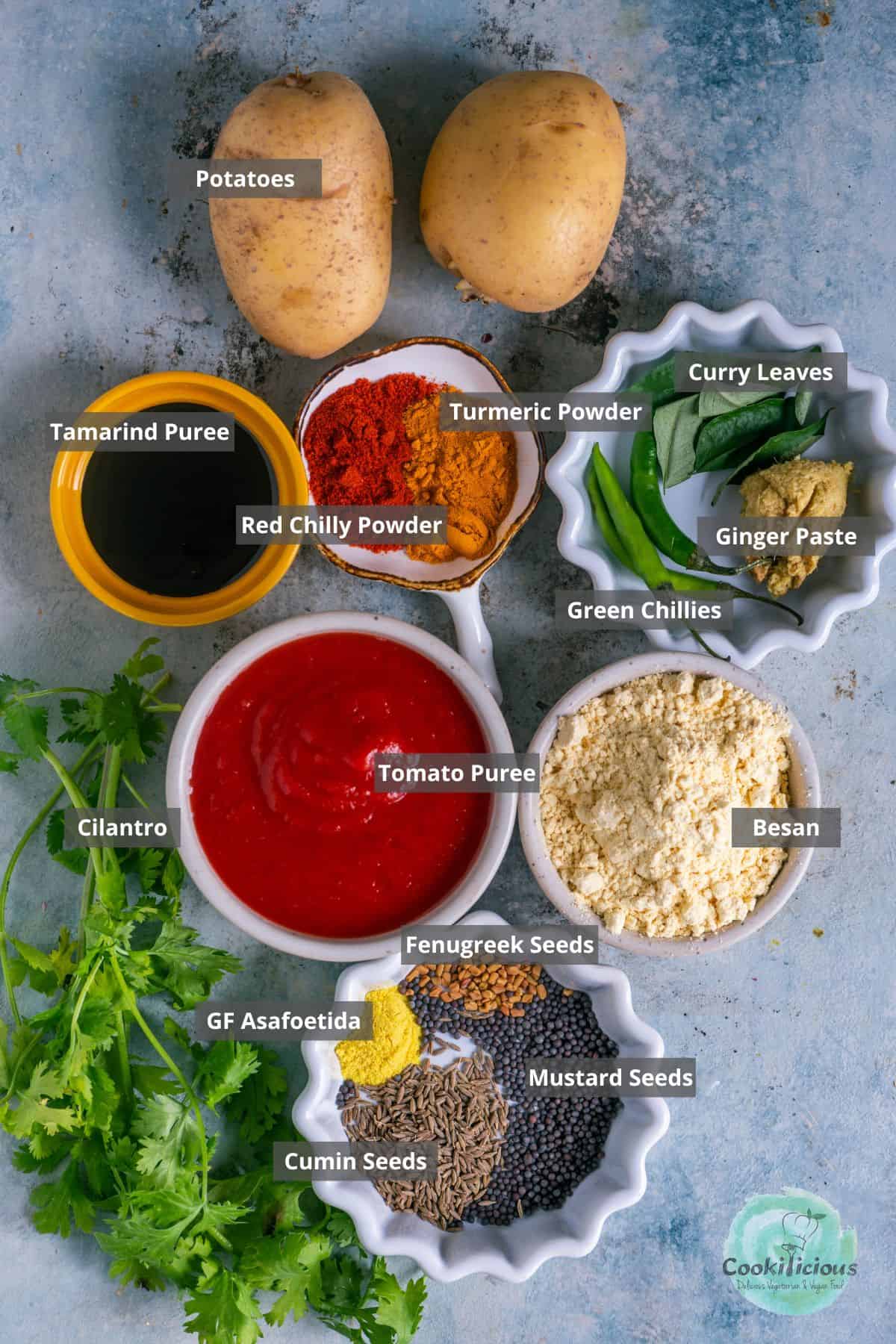
Besan: Gram flour, also known as besan or chickpea flour, forms the base of Sindhi Kadhi, providing a smooth and thick consistency.
Tomato Puree: For the best flavor, use fresh, ripe tomatoes to make your puree. Alternatively, you can use store-bought tomato puree. If you're using whole tamarind, take a lemon-sized ball, soak it in hot water for 15 minutes, then squeeze out the juice to add to the curry.
Tamarind: I prefer using store-bought tamarind pulp, puree, or paste, which adds a delightful tanginess to the Sindhi curry. If you don't have tamarind, you can substitute it with kokum or amchur powder, though the flavors will differ.
Vegetables: Feel free to customize the Sindhi Curry with any vegetables you like; I particularly enjoy making Sindhi Kadhi with aloo (potatoes).
Spices: The essential spices for this famous Sindhi dish include mustard seeds, cumin seeds, gluten-free asafoetida, fenugreek seeds, red chili powder, and turmeric powder.
Aromatics: To enhance the dish's flavor, add curry leaves, ginger paste, green chilies, and fresh cilantro for a refreshing aromatic touch.
How To Make It 🔪
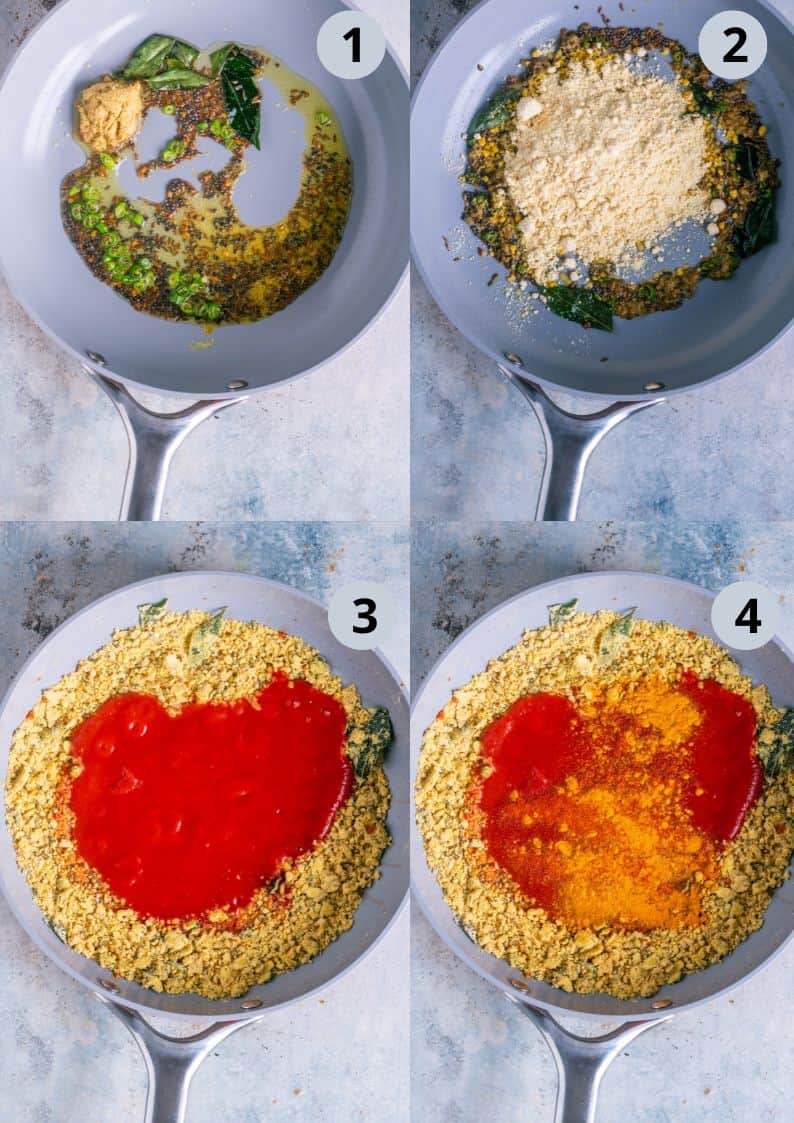
Want to save this recipe?
- In a pan, heat vegan ghee over medium heat. Add mustard seeds and cumin seeds, allowing them to sizzle and release their aromas. Then add gluten-free asafoetida, fenugreek seeds, curry leaves, ginger paste, and minced green chilies. Saute for a minute.
- Add besan (gram flour) to the pan. Lower the heat and roast it, stirring continuously until it turns light brown. This step is crucial as it imparts a nutty flavor to the Sindhi Kadhi. Be careful not to overcook it, as it can turn dark brown and bitter.
- Add the tomato puree and stir until fully blended.
- Sprinkle in turmeric powder and red chilly powder, mixing well to combine.
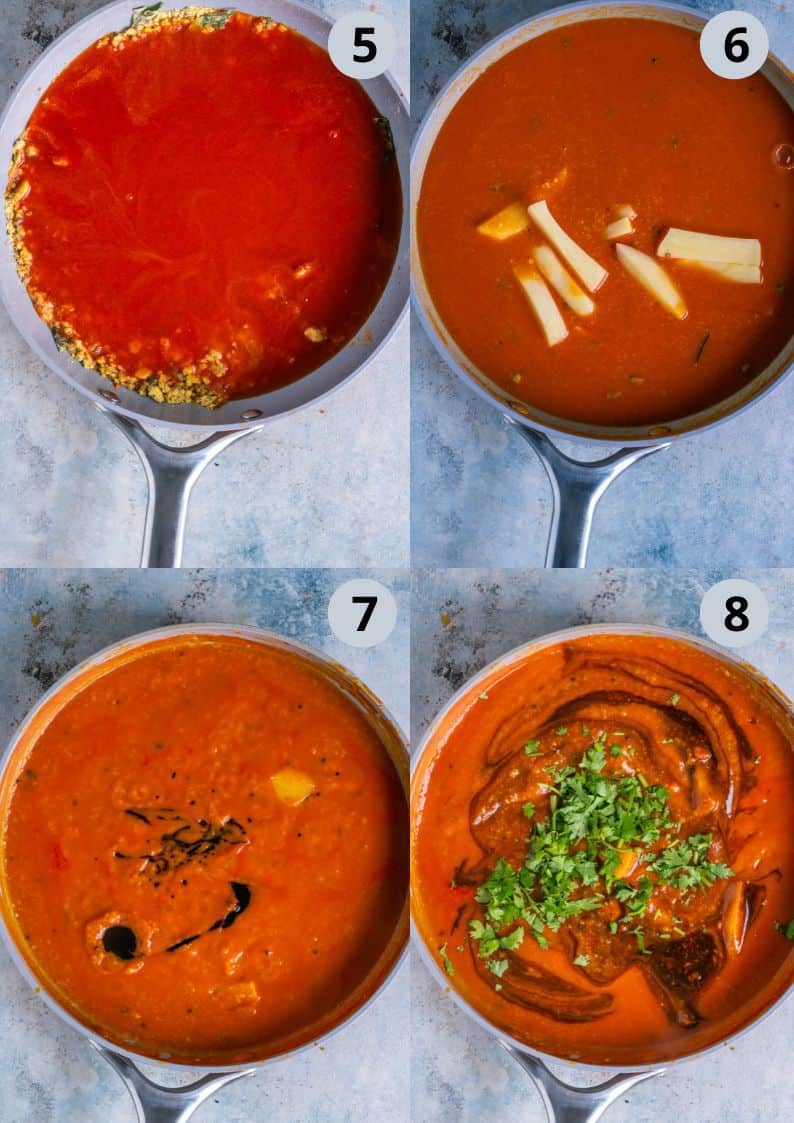
- Pour in water, then add salt and sugar. Mix well to ensure there are no lumps.
- Add the potato wedges to the pan. Cover and cook for 7-8 minutes, or until the potatoes are tender and the curry has slightly thickened.
- Stir in the tamarind paste and taste to adjust the seasonings as needed. If the Kadhi is too thick, add a bit of warm water to achieve your desired consistency. Chef Tip: If serving with rice, aim for a flowing consistency. For roti, a thicker Kadhi is ideal.
- Once done, garnish with chopped cilantro and remove the pan from the heat.

Serving Suggestions 🍽
Sindhi Kadhi is a main course best enjoyed with chawal (rice) and pairs wonderfully with pickles and fried or roasted papad. Here are some delicious serving options:
- Rice Varieties: Serve the Kadhi with cooked white rice, brown rice, Jeera Rice, Matar Pulao, or alternative grains like cooked quinoa. For a low-carb option, cauliflower rice works perfectly.
- Side Dishes: Enhance your meal with Onion Pakora or Raita on the side. This simple Sindhi Tomato Kadhi can also be enjoyed as a soup, reminiscent of Tomato Soup.
- Flatbreads: Sindhi Kadhi complements a variety of flatbreads such as roti, crepes, naan, puri, or paratha, making for a hearty meal.
Sindhi families often prepare this dish along with Aloo Tuk and rice for satisfying weekend lunches, particularly on Sundays. Since Sindhi Aloo Kadhi is made without onion and garlic, it's suitable for festive occasions such as weddings, Diwali, Navratri, Ganesh Chaturthi, Holi, and Raksha Bandhan. It can also be served alongside treats like Sweet Boondi and Sev.
This vegan Sindhi Tomato Kadhi is a versatile dish that shines at parties, potlucks, brunches, or any special occasion, including holidays like Thanksgiving or Christmas. Enjoy the warmth and flavor of Sindhi Kadhi with your loved ones!
Priya's Recipe Tips 💭
Use kokum instead of tamarind for a different flavor profile. Some households incorporate besan pakoras (fritters) into the Kadhi for added texture and flavor. Alternatively, you can fry the potatoes separately, (similar to making Nimona Matar), before adding them to the curry. An alternative to besan is 2-3 tablespoons of wheat flour (maida) mixed with a tablespoon of cashew powder.
FAQs 📖
Sindhi Tomato Kadhi is versatile and can be customized with a variety of vegetables. Here are some great options to consider: Drumsticks: A popular choice, these should be cooked or steamed before adding them to the Kadhi
Seasonal Vegetables: You can include eggplant, pumpkin, carrots, green beans, okra, zucchini, cauliflower, cluster beans (gavar), lotus stem (kamal kakdi), corn, yams, bitter gourd (karela), tindora, bottle gourd, taro root, and onions.
Depending on the type of vegetable, you can either stir-fry them separately or cook them directly in the Kadhi. Be sure to add the vegetables in order of their cooking times to ensure they retain their shape and don't become mushy-much like the method used in Avial.
Protein Options: For added nutrition, consider including paneer or tofu cubes, soya chunks, chickpeas, or sprouted beans.
Feel free to customize your Sindhi Kadhi based on seasonal availability and personal preferences!
It's a personal choice. If serving with rice, aim for a flowing consistency. For roti, a thicker Kadhi is ideal. If the consistency of the curry is too thin, prepare a flour slurry by mixing some flour with water and then add it to the curry. This will help thicken it to your desired consistency.
To prepare Sindhi Kadhi and Chawal together in the Instant Pot, use the pot-in-pot method for optimal results:
Add all the ingredients as per the Sindhi Curry recipe into the main pot.
Place a tall trivet inside the pot, and then position a container with rinsed rice on top of the trivet.
Select the Soup or Pressure Cook mode and cook everything together for 6 minutes.
Allow the pressure to release naturally for 5 minutes, then release any remaining pressure manually.
You'll have delicious Sindhi Kadhi and perfectly cooked chawal ready simultaneously!
Alternatively, you can add the rinsed rice directly with the vegetables and cook them all together to create a flavorful Kadhi Khichdi similar to Dal Khichdi. This method combines the goodness of Kadhi and rice into a comforting one-pot meal.
Refrigeration: Store leftovers in an airtight container in the fridge for 4-5 days. Keep in mind that Sindhi Curry tends to thicken as it cools.
Freezing: You can also freeze Aloo Kadhi. To do this, transfer it to a freezer-safe container and freeze for up to 2-3 months.
Thawing and Reheating: When ready to use, thaw the Curry overnight in the fridge. When reheating, add a bit of water to adjust the consistency, season with salt as needed, and reheat until warmed through.
This way, you can enjoy your Tomato Aloo Kadhi at a later time without losing its flavor and texture!
Indian Recipes Using Besan Flour

⭐️ Subscribe to the Cookilicious Newsletter and receive new recipes straight to your inbox! You'll receive my FREE Vegan Beginner's guide as a gift. Ready to elevate your cooking game? Purchase my Cookbook - The Essential Vegan Indian Cookbook today!
Recipe 📖

Sindhi Kadhi | Sindhi Curry Chawal
Equipment
Ingredients
- 1 tablespoon vegan ghee
- ½ teaspoon gluten-free asafoetida
- 1 teaspoon mustard seeds
- 1 teaspoon cumin seeds
- ⅛ teaspoon fenugreek seeds
- 5-6 curry leaves
- 1 tablespoon ginger paste
- 2-3 green chillies
- ¼ cup besan
- 1 cup tomato puree
- 4 cups water or vegetable stock
- 2 potatoes peeled, and cut in wedges
- 1 tablespoon tamarind paste
- salt
- 2 tablespoon cilantro
Instructions
- In a pan, heat vegan ghee over medium heat. Add mustard seeds and cumin seeds, allowing them to sizzle and release their aromas. Then add gluten-free asafoetida, fenugreek seeds, curry leaves, ginger paste, and minced green chilies. Saute for a minute.
- Add besan (gram flour) to the pan. Lower the heat and roast it, stirring continuously until it turns light brown. This step is crucial as it imparts a nutty flavor to the Sindhi Kadhi. Be careful not to overcook it, as it can turn dark brown and bitter.
- Add the tomato puree and stir until fully blended.
- Sprinkle in turmeric powder and red chilly powder, mixing well to combine.
- Pour in water, then add salt and sugar. Mix well to ensure there are no lumps.
- Add the potato wedges to the pan. Cover and cook for 7-8 minutes, or until the potatoes are tender and the curry has slightly thickened.
- Stir in the tamarind paste and taste to adjust the seasonings as needed. If the Kadhi is too thick, add a bit of warm water to achieve your desired consistency. Chef Tip: If serving with rice, aim for a flowing consistency. For roti, a thicker Kadhi is ideal.
- Once done, garnish with chopped cilantro and remove the pan from the heat.


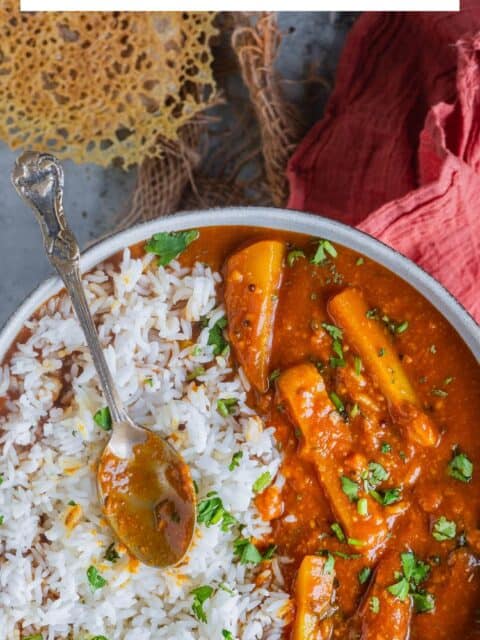

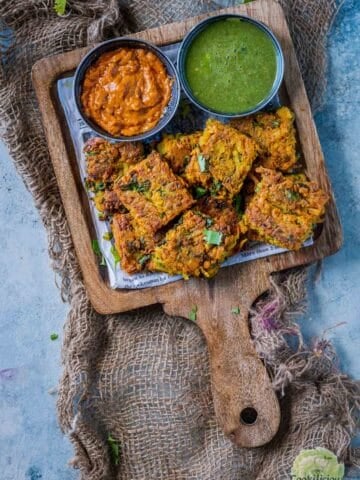
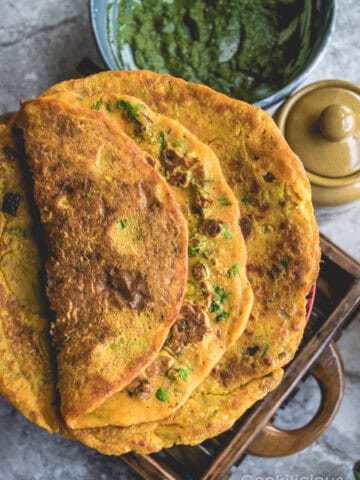
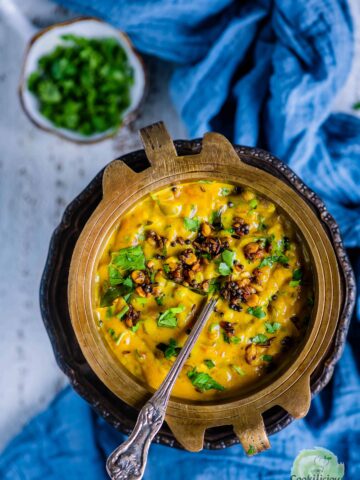



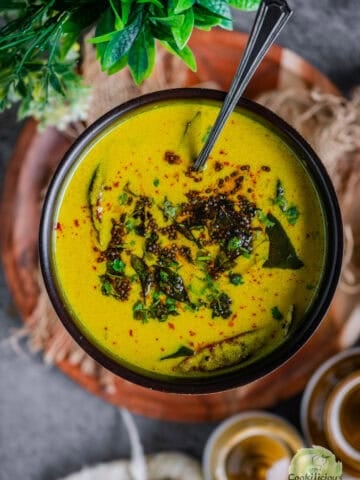
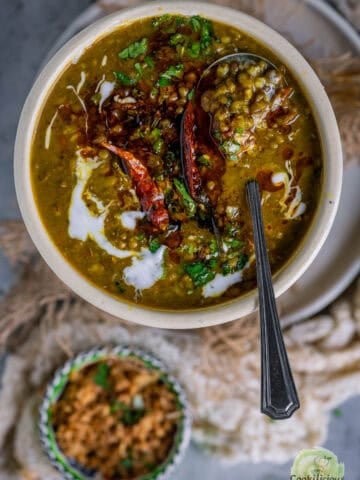
A. S.RAMAKRISHNAN says
Sindhi Kadhi looks delicious.